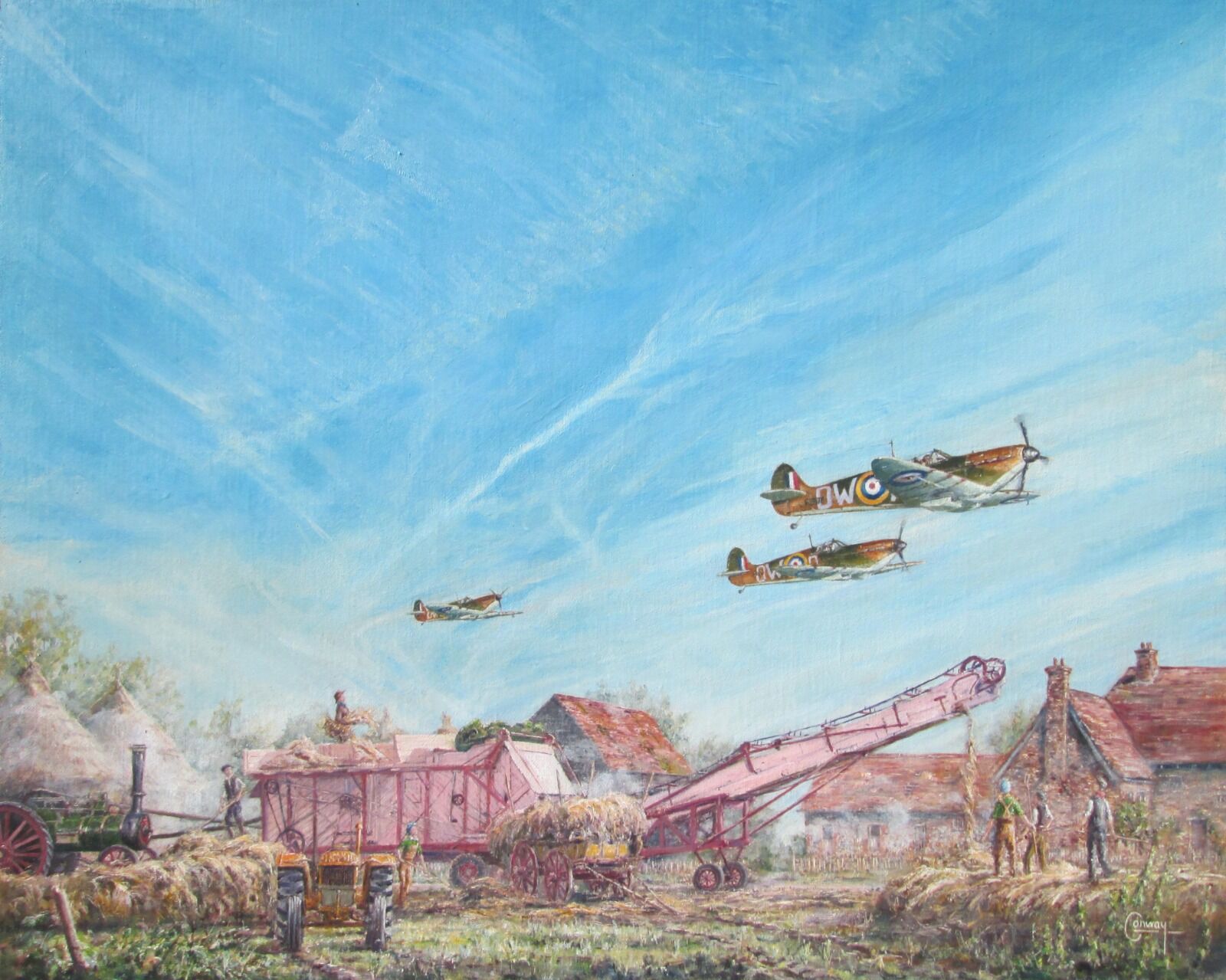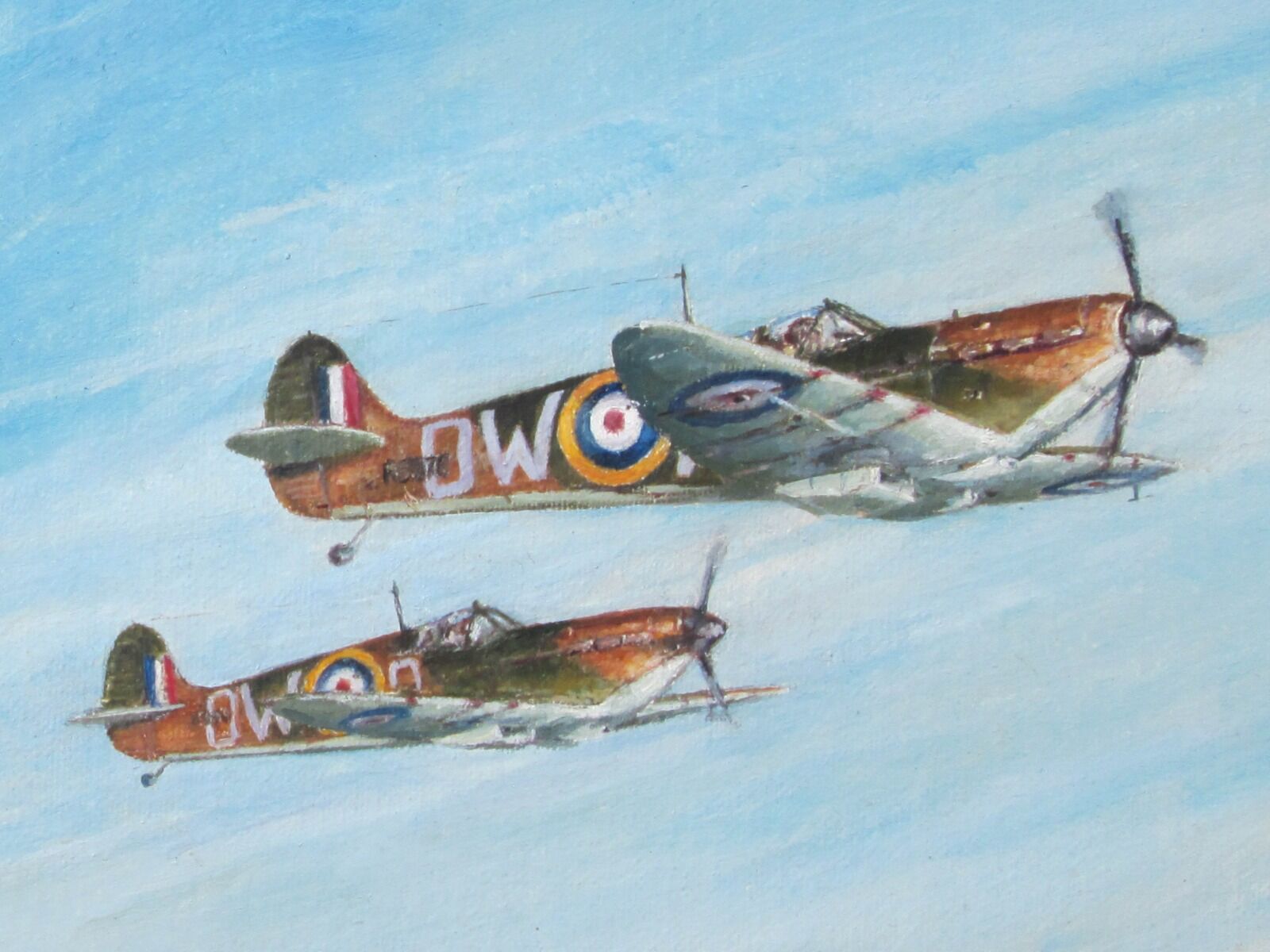610 Squadron Spitfires near Hawkinge
'Unceasing Endeavours' - Detailed Meaning From a Battle of Britain Painting (Part 1)


Sometimes a painting has more than one ‘story’ behind it, and this was very much so with this one.
This painting was prompted by reading one eyewitness account of the Battle of Britain, but then the research to pull in all the details into the painting seemed to just keep weaving more and more threads of stories into it.
It depicts the Spitfires of F/Lt. Peter Gilbert Lamb, Sgt. Ronald Fairfax Hamlyn and P/O. Claude Merrick, of 610 (County of Chester) Squadron, as they take off from RAF Hawkinge, Kent, on yet another sortie against the relentless pressures of the Luftwaffe. It is around 8am on the 24th August 1940. Below them, the work of the vital harvest of that year carries on, in spite of the Battle that rages daily above.
The painting title, ‘Unceasing Endeavours’, is in tribute of the unwavering efforts going on both in the sky and on the farms below, in that long hot summer, 85 years ago.
As the piece has so many stories that connect through it in my mind, I’ve written two articles on it. This one gives a brief insight into the tales of the three pilots whose aircraft are depicted in the painting, whilst the second article explores some of the meaning I see in all the activity on the farm below.
Although I had conducted some research on the pilots before commencing the painting, I was particularly struck by the detail that I had found about the Squadron and its activity over that summer given in the excellent book on the subject by David J. Bailey: ‘610 (County of Chester) Auxiliary Air Force Squadron, 1936- 1940’.
I found myself reading the book cover to cover over the same period that I actually painted the piece, very close to the 85th Anniversary of the moment I was painting and the events described in the book.
The experience of this was something I found especially moving and added a new depth to the threads of the stories of the pilots that I was depicting. I saw how those stories were briefly woven together in the weeks and months surrounding the day depicted, and yet also individually unravelled into an incredible trail forming a combined record of service, bravery and devotion from the beginning to the end of the war.
Unusually for the Battle too, all three pilots depicted would survive the war…
The painting depicts Yellow Section of 610 ‘County of Chester’ Squadron taking off for their first sortie of the day on the 24th August 1940.
They are led in the right-hand Spitfire by F/O. P.G. Lamb, who had already fought extensively with 610 Squadron in the skies over the Dunkirk evacuation and throughout the Squadron’s frontline service from the outset of the Battle of Britain; his name appears over and over again on the patrol lists throughout both campaigns. His subsequent wartime service included periods in instruction and as a test pilot, and he would go on to command 610 Squadron as a reformed Auxiliary Squadron after the war.
On this day, he would shoot down one Me109, witnessed by his No. 2, Sgt. R.F. Hamlyn…
Hamlyn’s Spitfire is the middle one in the painting. He joined the Squadron immediately after the fighting over Dunkirk and by the time of the painting, he too had fought continuously through the Battle of Britain. His experience was to show this day, being the only member of the Squadron to make contact with the enemy on this patrol, and bringing down an enemy bomber and fighter in this one sortie using only 500 rounds of ammunition. Later, on his 2nd and 3rd sorties of the day, he would remarkably bring down 3 more enemy fighter aircraft, a total of 5 in one day.
The last of these was almost certainly the Me109 attacking the Section’s no. 3, P/O. C. Merrick, and Hamlyn’s intervention may well have saved Merrick’s life. Hamlyn’s amazing later wartime service included the formation and command of 276 Air Sea Rescue Squadron and becoming Tactics Liaison Officer with the 9th USAF in the Normandy Campaign.
Merrick’s is the left-hand aircraft in the piece. Having only joined the Squadron 14 days before, the attack on his aircraft by an Me 109, fended off by Hamlyn, still cost him dearly, crash landing in a field in Essex with gunshot and shrapnel wounds. He would return to the Squadron in October, and his subsequent wartime career included piloting a special parachute drop for 10 Pathfinders at 00.17 hrs on D-Day, for them to illuminate the drop zone for the main parachute deployment.
So, whilst the painting is just an attempt to capture the briefest of moments in one hectic day of the Battle, it really feels like a story of so much more to me…
Three brave men briefly fighting for their lives and the freedom of their country alongside each other, as just a tiny part of their Herculean, sustained efforts throughout the war…
I think that Hamlyn’s own words on the Battle make the perfect last words here in summation of their incredible spirit:
“I knew we weren’t going to lose, though I didn’t know how we were going to win.”

Part 2 of this article explores all the meaning and stories behind the multitude of activities on the ground in the foreground of this painting:
'Unceasing Endeavours' - Detailed Meaning From a Battle of Britain Painting (Part 2)
This painting was prompted by reading one eyewitness account of the Battle of Britain, but then the research to pull in all the details into the painting seemed to just keep weaving more and more threads of stories into it.
It depicts the Spitfires of F/Lt. Peter Gilbert Lamb, Sgt. Ronald Fairfax Hamlyn and P/O. Claude Merrick, of 610 (County of Chester) Squadron, as they take off from RAF Hawkinge, Kent, on yet another sortie against the relentless pressures of the Luftwaffe. It is around 8am on the 24th August 1940. Below them, the work of the vital harvest of that year carries on, in spite of the Battle that rages daily above.
The painting title, ‘Unceasing Endeavours’, is in tribute of the unwavering efforts going on both in the sky and on the farms below, in that long hot summer, 85 years ago.
As the piece has so many stories that connect through it in my mind, I’ve written two articles on it. This one gives a brief insight into the tales of the three pilots whose aircraft are depicted in the painting, whilst the second article explores some of the meaning I see in all the activity on the farm below.
Although I had conducted some research on the pilots before commencing the painting, I was particularly struck by the detail that I had found about the Squadron and its activity over that summer given in the excellent book on the subject by David J. Bailey: ‘610 (County of Chester) Auxiliary Air Force Squadron, 1936- 1940’.
I found myself reading the book cover to cover over the same period that I actually painted the piece, very close to the 85th Anniversary of the moment I was painting and the events described in the book.
The experience of this was something I found especially moving and added a new depth to the threads of the stories of the pilots that I was depicting. I saw how those stories were briefly woven together in the weeks and months surrounding the day depicted, and yet also individually unravelled into an incredible trail forming a combined record of service, bravery and devotion from the beginning to the end of the war.
Unusually for the Battle too, all three pilots depicted would survive the war…
The painting depicts Yellow Section of 610 ‘County of Chester’ Squadron taking off for their first sortie of the day on the 24th August 1940.
They are led in the right-hand Spitfire by F/O. P.G. Lamb, who had already fought extensively with 610 Squadron in the skies over the Dunkirk evacuation and throughout the Squadron’s frontline service from the outset of the Battle of Britain; his name appears over and over again on the patrol lists throughout both campaigns. His subsequent wartime service included periods in instruction and as a test pilot, and he would go on to command 610 Squadron as a reformed Auxiliary Squadron after the war.
On this day, he would shoot down one Me109, witnessed by his No. 2, Sgt. R.F. Hamlyn…
Hamlyn’s Spitfire is the middle one in the painting. He joined the Squadron immediately after the fighting over Dunkirk and by the time of the painting, he too had fought continuously through the Battle of Britain. His experience was to show this day, being the only member of the Squadron to make contact with the enemy on this patrol, and bringing down an enemy bomber and fighter in this one sortie using only 500 rounds of ammunition. Later, on his 2nd and 3rd sorties of the day, he would remarkably bring down 3 more enemy fighter aircraft, a total of 5 in one day.
The last of these was almost certainly the Me109 attacking the Section’s no. 3, P/O. C. Merrick, and Hamlyn’s intervention may well have saved Merrick’s life. Hamlyn’s amazing later wartime service included the formation and command of 276 Air Sea Rescue Squadron and becoming Tactics Liaison Officer with the 9th USAF in the Normandy Campaign.
Merrick’s is the left-hand aircraft in the piece. Having only joined the Squadron 14 days before, the attack on his aircraft by an Me 109, fended off by Hamlyn, still cost him dearly, crash landing in a field in Essex with gunshot and shrapnel wounds. He would return to the Squadron in October, and his subsequent wartime career included piloting a special parachute drop for 10 Pathfinders at 00.17 hrs on D-Day, for them to illuminate the drop zone for the main parachute deployment.
So, whilst the painting is just an attempt to capture the briefest of moments in one hectic day of the Battle, it really feels like a story of so much more to me…
Three brave men briefly fighting for their lives and the freedom of their country alongside each other, as just a tiny part of their Herculean, sustained efforts throughout the war…
I think that Hamlyn’s own words on the Battle make the perfect last words here in summation of their incredible spirit:
“I knew we weren’t going to lose, though I didn’t know how we were going to win.”

Part 2 of this article explores all the meaning and stories behind the multitude of activities on the ground in the foreground of this painting:
'Unceasing Endeavours' - Detailed Meaning From a Battle of Britain Painting (Part 2)
